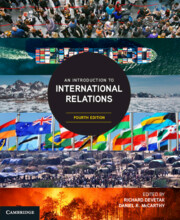Book contents
- Frontmatter
- Contents
- Tables, figures and boxes
- Contributors
- Preface and acknowledgements
- Guide to online instructor resources
- Introduction: The origins and changing agendas of international relations
- Part 1 Theories of International Relations
- Part 2 International history
- Part 3 The traditional agenda: States, wars and law
- Part 4 The new agenda: Globalisation and global challenges
- Chapter 20 Non-state actors: A sociology of International Relations?
- Chapter 21 Religion and secularism
- Chapter 22 Global economic institutions
- Chapter 23 Global trade and finance
- Chapter 24 Global poverty, inequality and development
- Chapter 25 Globalisation and its critics
- Chapter 26 Terrorism
- Chapter 27 The international politics of cyberspace
- Chapter 28 The changing character of warfare
- Chapter 29 Post-conflict state-building
- Chapter 30 Humanitarianism and armed intervention
- Chapter 31 Human rights
- Chapter 32 Global public health
- Chapter 33 Migration and refugees
- Chapter 34 Global environmental politics
- Chapter 35 Climate change
- Chapter 36 The futures of International Relations
- References
- Index
- Figure and text acknowledgements
Chapter 33 - Migration and refugees
from Part 4 - The new agenda: Globalisation and global challenges
Published online by Cambridge University Press: aN Invalid Date NaN
- Frontmatter
- Contents
- Tables, figures and boxes
- Contributors
- Preface and acknowledgements
- Guide to online instructor resources
- Introduction: The origins and changing agendas of international relations
- Part 1 Theories of International Relations
- Part 2 International history
- Part 3 The traditional agenda: States, wars and law
- Part 4 The new agenda: Globalisation and global challenges
- Chapter 20 Non-state actors: A sociology of International Relations?
- Chapter 21 Religion and secularism
- Chapter 22 Global economic institutions
- Chapter 23 Global trade and finance
- Chapter 24 Global poverty, inequality and development
- Chapter 25 Globalisation and its critics
- Chapter 26 Terrorism
- Chapter 27 The international politics of cyberspace
- Chapter 28 The changing character of warfare
- Chapter 29 Post-conflict state-building
- Chapter 30 Humanitarianism and armed intervention
- Chapter 31 Human rights
- Chapter 32 Global public health
- Chapter 33 Migration and refugees
- Chapter 34 Global environmental politics
- Chapter 35 Climate change
- Chapter 36 The futures of International Relations
- References
- Index
- Figure and text acknowledgements
Summary
The first section of this chapter looks at how the two terms ‘migrant’ and ‘refugee’ came to be defined as distinct from each other in the context of the modern state. The second examines how states define and categorise refugees through laws that seek to contain and limit their flow. The third section is concerned with the consequences of limiting the definition of a refugee, which has led to an unequal burden between developed and developing states. The final section will canvass the various options presented to reduce the present imbalance where the vast majority of the world’s refugees eke out an existence in refugee camps in developing countries. Ultimately, this chapter seeks to demonstrate that the choices made by states in border protection become the key determinants of how refugees will be accepted. Adherence to international refugee law will not necessarily address all the problems associated with refugees, but nor will seeing refugees as unwanted intruders in contrast to ‘desirable’ migrants.
Keywords
- Type
- Chapter
- Information
- An Introduction to International Relations , pp. 439 - 452Publisher: Cambridge University PressPrint publication year: 2024



